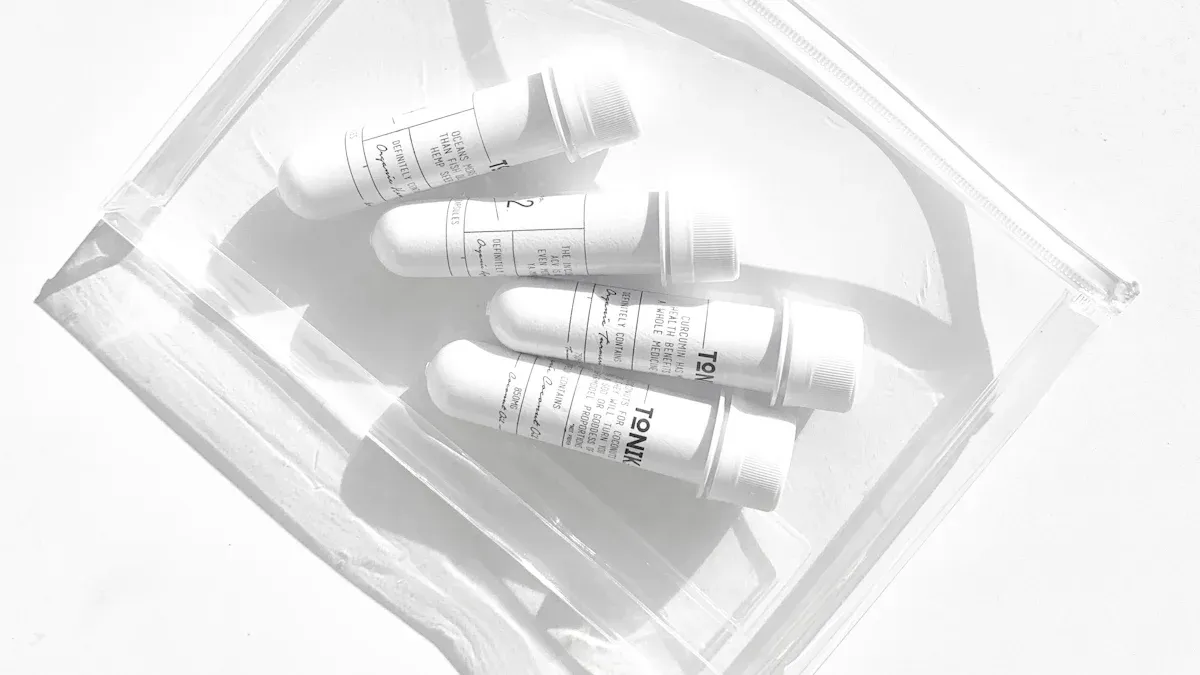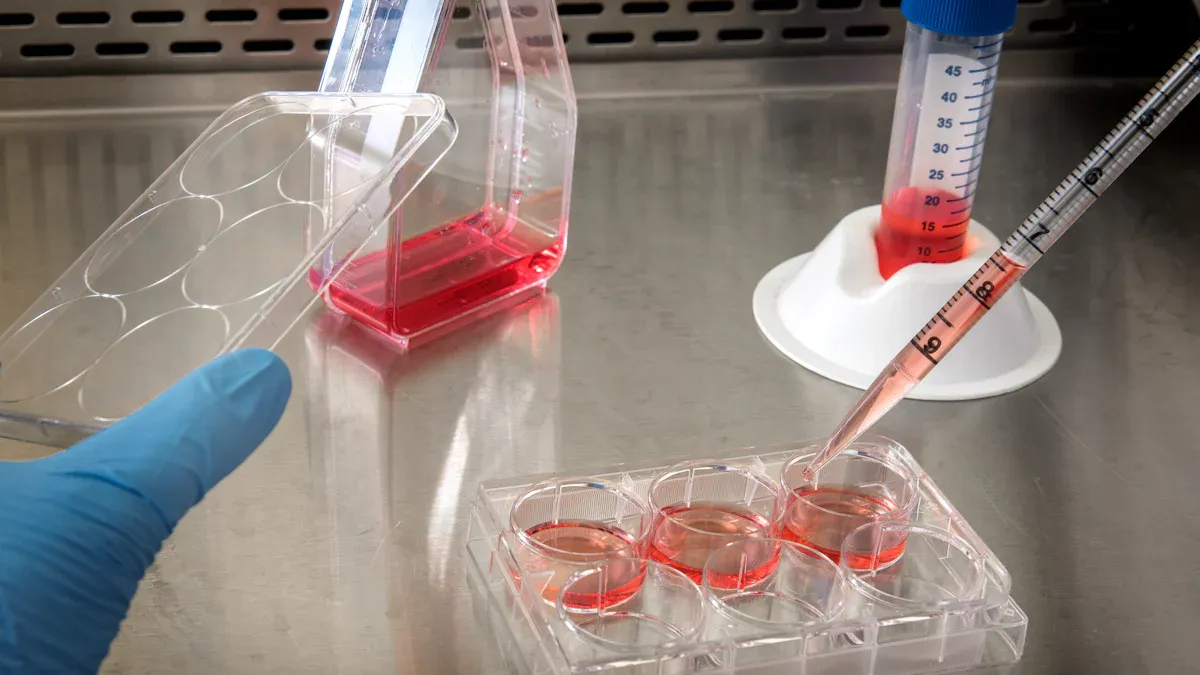PET Tube Medical Solutions for Safer Devices

PET heat shrink tubing plays a vital role in the medical field by providing a reliable solution for enhancing device performance and safety. This specialized tubing, made from polyethylene terephthalate, contracts when heated, creating a snug fit around sensitive components. Its biocompatibility and precision contribute to safer medical devices, especially in critical applications.
Demand for PET tube medical solutions continues to rise. Sales of Class III devices using this tubing grew by 17% in 2023, highlighting its importance. The medical heat shrink tubing market is also projected to reach $600 million by 2033, reflecting its expanding adoption due to its favorable properties.
Key Takeaways
PET shrink tubing makes medical devices safer and work better.
It fits tightly around delicate parts to protect them.
This tubing is safe to touch human tissue, keeping patients safe.
PET tubing is strong and can handle chemicals and heat well.
It stays useful even after being cleaned many times.
Manufacturers can customize PET tubing size and features to improve devices.
More people want PET tubing because it helps make better medical tools.
Understanding PET Heat Shrink Tubing

What Is PET Heat Shrink Tubing?
PET heat shrink tubing is a specialized material made from polyethylene terephthalate, a durable plastic polymer. This tubing contracts when exposed to heat, forming a tight, protective layer around wires, cables, or other components. In medical applications, it serves as an insulator for electrical components, particularly in energy-generating devices, due to its high dielectric strength. Its ability to shield sensitive parts from potential damage makes it indispensable in healthcare.
The use of PET heat shrink tubing has revolutionized medical device manufacturing. It replaces traditional methods for covering high-pressure catheters and micro-wire devices, enhancing their performance. Advancements in material science have also led to thinner, more effective tubing, which improves functionality in clinical settings.
Key Properties of PET Tubing
PET heat shrink tubing offers several key properties that make it ideal for medical use:
Durability: PET is highly resistant to wear and tear, ensuring long-lasting performance.
Chemical Resistance: It withstands exposure to various chemicals, maintaining its integrity in challenging environments.
Biocompatibility: PET tubing is safe for use in medical devices, as it does not cause adverse reactions when in contact with human tissue.
Thermal Stability: It can endure high temperatures without losing its structural integrity.
Precision: The tubing contracts uniformly when heated, providing a snug fit around components.
These properties contribute to the tubing's widespread adoption in healthcare, where reliability and safety are paramount.
Why PET Is a Preferred Material for Medical Use
PET stands out among other polymers due to its unique advantages. It exhibits the lowest water contact angle (WCA) of 70.67° ± 0.15, making it the most hydrophilic material compared to alternatives like HDPE, PVC, PP, and acrylic. This hydrophilicity promotes faster bacterial attachment, which is beneficial in certain medical applications.
Additionally, PET heat shrink tubing enhances the durability, safety, and functionality of medical devices. Its ability to form a secure, protective layer around components ensures optimal performance in critical applications. The material's versatility and reliability make it a preferred choice for manufacturers seeking to improve the quality of their products.
Benefits of PET Tube Medical Applications
Safety and Biocompatibility
PET heat shrink tubing offers exceptional safety and biocompatibility, making it a trusted choice for medical devices. Its biocompatible applications ensure that the material does not cause adverse reactions when in contact with human tissue. Regulatory standards, such as ISO 10993, require rigorous testing to confirm the safety of materials used in healthcare. PET tubing meets these standards through assessments of cytotoxicity and sterilization compatibility.
A 2023 study demonstrated PET tubing's durability under repeated sterilization. After 50 cycles of hydrogen peroxide sterilization, the tubing retained 88% of its tensile strength. This resilience ensures that PET heat shrink tubing remains safe and effective even after multiple uses. Its ability to withstand sterilization methods like ethylene oxide and gamma rays further enhances its suitability for biocompatible applications.
In clinical settings, PET tubing contributes to improved patient outcomes. For example:
Multiparametric PET imaging enhances the characterization of malignant diseases, such as breast cancer.
Dynamic PET imaging improves treatment planning by evaluating kinetic patterns of radiotracers.
These techniques allow for better disease delineation and more accurate treatment customization.
The combination of safety, biocompatibility, and clinical benefits makes PET tubing indispensable in modern healthcare.
Durability and Resistance to Environmental Stress
PET heat shrink tubing is renowned for its durability and resistance to environmental stress. Its robust structure ensures long-lasting performance, even in challenging conditions. The material resists wear and tear, maintaining its integrity when exposed to chemicals, high temperatures, or mechanical stress.
In medical applications, durability is critical. Devices often undergo repeated sterilization, exposure to bodily fluids, and mechanical strain. PET tubing excels in these scenarios, retaining its properties over time. For instance, it shows minimal degradation after exposure to sterilization methods like hydrogen peroxide and gamma rays. This reliability ensures that medical devices remain functional and safe throughout their lifespan.
The tubing's chemical resistance also plays a vital role. It withstands exposure to various substances, including cleaning agents and bodily fluids, without compromising its performance. This resistance reduces the risk of device failure, enhancing patient safety.
By combining durability with resistance to environmental stress, PET heat shrink tubing ensures that medical devices perform reliably in demanding healthcare environments.
Precision and Customization for Medical Devices
PET heat shrink tubing offers unmatched precision and customization, making it ideal for advanced medical devices. Its ability to contract uniformly when heated ensures a snug fit around components, enhancing device functionality. Manufacturers can customize the tubing's dimensions, wall thickness, and surface properties to meet specific requirements.
The following table highlights the technical capabilities of PET tubing:
Parameter | Value |
|---|---|
Inner Diameter | 0.25 |
Wall Thickness | 0.005~0.200mm (0.0002''-0.008'') |
Length | ≤2100mm |
Color | Clear, Black, White, and Customized |
Shrink Ratio | 1.2:1, 1.5:1, 2:1 |
Shrink Temperature | 90°C |
Melting Point | 247±2°C (476.6±3.6°F) |
Tensile Strength | ≥30000PSI |
Biocompatibility | Meets ISO 10993 and USP Class VI |
Sterilization Method | Ethylene oxide, gamma rays, electron beam |
Environmental Protection | RoHS Compliant |
Customization extends beyond dimensions. Surface treatments can enhance properties like antimicrobial resistance, making the tubing suitable for specialized applications. For example, PET tubing is commonly used in nerve conduits for nerve repair and regeneration. Its strength and flexibility mimic the natural structure of nerves, promoting effective healing.
The precision and adaptability of PET heat shrink tubing enable manufacturers to create innovative medical devices tailored to specific clinical needs.
Common Uses of PET Heat Shrink Tubing in Healthcare

Catheter Manufacturing and Vascular Applications
PET heat shrink tubing plays a critical role in catheter manufacturing and vascular applications. Its ability to provide variable stiffness makes it ideal for creating catheters that navigate complex anatomical pathways. Different thicknesses of the tubing allow manufacturers to design catheters with varying flexibility, ensuring precision during medical procedures. This adaptability enhances catheter performance, improving maneuverability and reducing the risk of compression or kinking.
In vascular applications, PET heat shrink tubing offers insulation and protection for catheters and guidewires. This reduces tissue damage and enhances patient comfort during procedures. Its biocompatibility ensures safety, while its durability allows it to withstand the mechanical stress of insertion and removal. These qualities make PET tubing indispensable in the development of advanced vascular devices.
Surgical Instruments and Protective Coatings
Surgical instruments benefit significantly from the use of PET heat shrink tubing. The tubing acts as a protective coating, shielding delicate components from damage during use and sterilization. This protection ensures that instruments remain functional and safe, even after repeated exposure to harsh sterilization methods like gamma rays or ethylene oxide.
The tubing’s precision and customization capabilities also enhance surgical instruments. Manufacturers can tailor the tubing’s dimensions and properties to meet specific requirements, ensuring optimal performance. For example, PET tubing is often used to coat handles or other parts of surgical tools, providing a secure grip and reducing the risk of slippage during procedures. This combination of protection and functionality makes PET tubing a valuable addition to modern surgical instruments.
Electrical Insulation for Medical Equipment
PET heat shrink tubing provides reliable electrical insulation for medical equipment. Its high dielectric strength prevents electrical interference, ensuring the safe and efficient operation of electronic medical devices. The tubing also shields components from moisture and physical damage, enhancing the durability and reliability of the equipment.
Diagnostic tools, such as imaging devices, rely on PET tubing to maintain performance in challenging environments. The tubing’s chemical resistance and thermal stability ensure that these tools deliver accurate results, even under demanding conditions. By protecting sensitive components, PET tubing contributes to the overall safety and effectiveness of medical equipment, making it a preferred choice for manufacturers.
PET Heat Shrink Tubing vs. Alternative Materials
PET vs. PVC: A Comparative Analysis
PET heat shrink tubing and PVC (polyvinyl chloride) are both widely used in medical applications, but they differ significantly in performance and safety. PET tubing offers superior thermal stability and chemical resistance, making it ideal for environments requiring repeated sterilization. In contrast, PVC tends to degrade under high temperatures and prolonged exposure to sterilization methods, limiting its lifespan in medical devices.
PVC is more flexible than PET, which can be advantageous in certain applications. However, PET’s durability and biocompatibility make it a safer choice for critical healthcare uses. Additionally, PET tubing does not release harmful plasticizers, unlike PVC, which can leach phthalates over time. This makes PET tubing a more environmentally friendly and patient-safe option.
PET vs. Silicone: Key Differences
Silicone is another popular material in medical applications, known for its flexibility and biocompatibility. However, PET heat shrink tubing surpasses silicone in areas like mechanical strength and thermal stability. PET tubing maintains its structural integrity even after exposure to high temperatures, while silicone may lose its shape under similar conditions.
Silicone is often used in devices that require direct contact with human tissue due to its softness. PET tubing, on the other hand, excels in applications requiring precision and durability, such as electrical insulation and catheter manufacturing. Its ability to provide a snug, uniform fit around components ensures optimal performance in these scenarios.
The following table highlights the key properties and applications of PET tubing compared to other materials:
Material | Key Properties | Applications |
|---|---|---|
PET Heat Shrink | Reliable electrical insulation, thermal stability | Electrical components, medical devices |
Silicone | Flexibility, biocompatibility | Devices in contact with tissues |
Polyurethane | Durability, cost-effectiveness | General insulation |
PTFE | Chemical resistance, high dielectric strength | Harsh chemical environments |
Polyimide | Thermal insulation in high temperatures | High-temperature applications |
Unique Advantages of PET Heat Shrink Tubing
PET heat shrink tubing offers several unique advantages that set it apart from alternative materials. Its ability to endure high-temperature sterilization without degradation ensures long-term reliability in medical devices. The tubing retains its mechanical properties even after exposure to irradiation, making it suitable for repeated use. For instance, PET tubing can withstand over 25 sterilization cycles without losing dimensional stability.
Additionally, PET tubing adapts to diverse medical device designs, providing a precise fit that enhances performance. Its biocompatibility, confirmed by ISO 10993 and USP Class VI standards, ensures safety in applications like catheters and surgical instruments. The material also protects against bodily fluids and chemicals, further enhancing its durability.
The following table summarizes PET tubing’s unique properties:
Property | Description |
|---|---|
Sterilization Resistance | Endures high-temperature sterilization without degradation. |
Mechanical Property Retention | Maintains mechanical properties post-irradiation. |
Durability in Reprocessing | Capable of ≥25 sterilization cycles without dimensional stability loss. |
These features make PET heat shrink tubing a reliable and versatile choice for medical applications, outperforming alternatives like PVC and silicone in critical areas.
Regulatory and Safety Standards for PET Tubing
Compliance with Medical Industry Standards
PET tubing used in medical equipment must adhere to stringent industry standards to ensure safety and reliability. Regulatory frameworks like USP Class VI, ISO 10993, and FDA Title 21 outline the requirements for materials used in healthcare applications. These standards evaluate biocompatibility, toxicity, and performance under various conditions.
The following table summarizes key regulatory standards:
Regulatory Standard | Description |
|---|---|
USP Class VI | Sets biocompatibility testing standards for medical devices, requiring specific tests for certification. |
ISO 10993 | Defines biocompatibility testing categories and requirements for medical devices based on body contact and exposure duration. |
FDA Title 21 | Regulates materials used in medical devices, ensuring they are safe and non-toxic for human use. |
By meeting these standards, PET tubing ensures compatibility with human tissue and compliance with global safety regulations. This makes it a trusted choice for manufacturers of medical equipment.
Certifications and Quality Assurance
Certifications play a vital role in verifying the quality and safety of PET tubing. Standards like ISO 10993 and USP Class VI confirm that the tubing is free from harmful chemicals and safe for prolonged use. FDA approval further ensures compliance with U.S. regulations for medical devices.
The table below highlights essential certifications:
Compliance Standard | Description |
|---|---|
ISO 10993 | Evaluates the biocompatibility of materials used in medical devices, ensuring PET tubing does not cause adverse reactions with human tissue. |
USP Class VI | Certifies that the tubing is free from harmful chemicals and safe for prolonged use in medical environments. |
FDA Approval | Confirms compliance with FDA regulations for medical devices sold in the United States. |
These certifications provide assurance to manufacturers and healthcare providers that PET tubing meets the highest quality standards. This reliability is crucial for medical equipment used in critical applications.
Ensuring Patient Safety with PET Tubing
Patient safety remains a top priority in the design and manufacturing of medical equipment. PET tubing contributes to this goal by offering biocompatibility, durability, and resistance to environmental stress. Its compliance with ISO 10993 and USP Class VI ensures that it does not cause adverse reactions when in contact with human tissue.
The tubing's ability to withstand repeated sterilization cycles without degradation enhances its safety profile. For example, PET tubing retains its mechanical properties even after exposure to high temperatures or gamma rays. This resilience ensures that medical equipment remains functional and safe throughout its lifespan.
By adhering to rigorous regulatory standards and certifications, PET tubing plays a critical role in safeguarding patient health. Its reliability and performance make it an indispensable component in modern healthcare.
PET heat shrink tubing offers unmatched safety, durability, and precision for medical applications. Its biocompatibility and resistance to environmental stress ensure reliable performance in critical healthcare settings. As the medical device industry shifts toward sustainability, PET tubing aligns with eco-friendly practices by offering recyclable options. Additionally, the growing demand for advanced devices integrating smart technologies highlights the importance of materials like PET tubing. These trends underscore the value of adopting pet tube medical solutions to create safer, more effective devices that meet modern healthcare needs.
FAQ
What makes PET heat shrink tubing suitable for electronic medical devices?
PET heat shrink tubing offers high dielectric strength and thermal stability. These properties ensure reliable insulation for electronic medical devices, protecting sensitive components from electrical interference and environmental stress. Its durability enhances device safety and performance in critical healthcare applications.
How does PET tubing improve diagnostic tools?
PET tubing enhances diagnostic tools by providing precise insulation and protection for electronic components. Its chemical resistance ensures accurate performance even in harsh environments. This reliability supports tools like imaging devices, which require consistent functionality for effective diagnostics.
Can PET tubing withstand repeated sterilization?
Yes, PET tubing retains its mechanical properties after multiple sterilization cycles. It endures methods like gamma rays and ethylene oxide without degradation. This resilience ensures its suitability for reusable electronic medical devices and diagnostic tools.
Is PET tubing customizable for specific medical applications?
Manufacturers can customize PET tubing to meet specific requirements. Adjustments in dimensions, wall thickness, and surface properties allow it to fit various electronic medical devices and diagnostic tools. This adaptability ensures optimal performance in diverse healthcare settings.
How does PET tubing contribute to patient safety?
PET tubing ensures patient safety through its biocompatibility and resistance to environmental stress. It meets ISO 10993 standards, confirming its non-toxic nature. Its durability and reliability make it a trusted choice for electronic medical devices and diagnostic tools.
See Also
Key Uses of Ultrathin PET Heat Shrink Tubing in Healthcare
The Importance of Ultra-Thin PET Heat Shrink Tubing in Medicine
Selecting the Optimal FEP Tubing for Medical Applications

